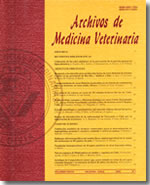Diphyllobothriosis in man and fishes from Lake Riñihue, Chile: effect of health education, seasonal distribution and its relation with sex, length and diet of the fish
Main Article Content
Abstract
Diphyllobothriosis is a zoonotic infection that develops, in South America, in introduced salmon and autochthonous fishes of Chile and Argentina. The prevalence of diphyllobothriosis in men and dogs in the riverside sector of Lake Riñihue during 1991-1992 was compared with prevalence in 1986-1987 and 1951 to evaluate its impact of the health education. Likewise, the prevalence and intensity of the infection by Diphyllobothrium latum and Diphyllobothrium dendriticum in the introduced rainbow trout Oncorhynchus mykiss, and autochthonous fishes was determined for Lake Riñihue. For the 1986-1987 period, the prevalence of diphyllobothriosis in men and dogs was similar to the 1991-1992 period, but human infection was significantly greater in 1951 with respect to last period. The prevalence and mean intensities of infection by D. dendriticum in rainbow trout presented significant differences, with greater parameters in 1986-1987. For D. latum, prevalence and mean intensity were similar in both periods. The prevalence and intensity of infection by Diphyllobothrium spp. did not present significant differences among the seasons. Only the prevalence of infection by D. dendriticum presented significant differences with respect to the sex of the trout. Trout length had an influence on the prevalence of diphyllobothriosis. Among autochthonous fishes, the silverside, Basilichthys australis, the puye Galaxias maculatus and the perch Percichthys trucha are reported for the first time in Chile, as hosts of D. dendriticum. Only trout and perch presented diphyllobothriosis in muscles. The diet of adult trout and perch suggests that they become infected principally through the consumption of other fish. Infection of cauque, Cauque mauleanum, silversides, puyes and young perch would be through the consumption of copepods.

